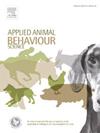探索妊娠母猪喂养模式的个体差异:应用自组织图来揭示行为类型
IF 2.2
2区 农林科学
Q1 AGRICULTURE, DAIRY & ANIMAL SCIENCE
引用次数: 0
摘要
怀孕母猪内部和之间的大行为差异阻碍了区分正常和偏离的喂养行为。确定母猪的不同行为类型有助于了解变化并改进电子母猪饲养器(ESFs)数据的使用,以监测母猪的性能和福利。本研究旨在探讨妊娠期母猪摄食模式中存在的行为类型,重点关注与频率和时间相关的摄食特征。为此,使用了自组织地图(SOMs)。SOM是一种无监督的机器学习方法,提供了充分的可视化支持。数据来自两个农场(传统农场1080头,有机农场439头)共1519头母猪妊娠,并进行了处理和清洗。分析了饲料周期(24 h)水平上的6个饲喂性状:1)营养性(N-)访问次数(有饲料量)之和,2)非营养性(NN-)访问次数(无饲料量)之和,3)第一次N-访问时间(N-start), 4)第一次NN-访问时间(NN-start), 5)一个饲料周期内NN-访问时间的四分位数间隔(NN- iqr), 6)最后一次N-访问与第一次NN-访问的时间间隔(N-NN-range)。每个农场分别分析了这些性状,因此总共训练了12名SOMs。每个SOM将母猪妊娠模式分为三组,以代表妊娠期间不同的行为模式。在三个性状(n次访问、n次访问和n - iqr)中,一种模式占主导地位,个别母猪只有偶尔的偏差。而N-start、n - NN-start和N-NN-range三个时间相关性状则没有明显的优势模式,表明存在共存模式。这些集群模式在水平、趋势和规律上都有所不同。根据饲养性状、妊娠期和养殖场的不同,群体中一种行为的平均表达量大多不同,但在妊娠期也可能呈现不同的增加、减少和变化趋势。特别是与网络访问相关的取食性状呈现出更多模式变化的聚类,可以反映行为类型。在不同的农场、妊娠期和母猪胎次之间也观察到饲养模式的差异,表明这些因素对理解饲养性状的变化很重要。事实证明,som作为一种获得第一手见解的工具非常有用。进一步分析以理解模式的含义并量化模式的最相关方面将在未来的研究中有价值。本文章由计算机程序翻译,如有差异,请以英文原文为准。
Exploring individual variation in gestating sows’ feeding patterns: applying self-organising maps to reveal behavioural types
Large behavioural variation within and among gestating sows hampers distinguishing normal from deviating feeding behaviour. Identifying different behavioural types in sows can contribute to understanding variation and improving the use of electronic sow feeders (ESFs) data for monitoring sow performance and welfare. The aim of this study is to explore the existence of behavioural types in sows’ feeding patterns during the gestation period, focussing on frequency and timing-related feeding traits. For this, self-organising maps (SOMs) were used. A SOM is an unsupervised machine learning method providing ample visualisation support. Data were obtained from in total 1519 sow gestations on two farms (1080 conventional and 439 organic) and were processed and cleaned. Six feeding traits on feed cycle (24 h) level were analysed: 1) sum of nutritive (N-)visits (with feed allowance), 2) sum of non-nutritive (NN-)visits (without feed allowance), 3) hour of the first N-visit (N-start), 4) hour of the first NN-visit (NN-start), 5) interquartile range in hours between NN-visits in one feed cycle (NN-IQR), 6) interval in hours between the last N-visit and first NN-visit (N-NN-range). These traits were analysed separately per farm, thus in total 12 SOMs were trained. Sow gestation patterns were grouped into three clusters per SOM to represent different behavioural patterns during gestation. For three of the traits (N-visits, NN-visits and NN-IQR), one pattern was dominant, with only occasional deviations in individual sows. In contrast, the other three (timing-related) traits N-start, NN-start and N-NN-range showed no clear dominant pattern, suggesting the presence of coexisting patterns. These cluster patterns differed in level, trends and regularity. Depending on the feeding trait, gestation phase and farm, patterns in clusters could mostly differ in average expression of a behaviour, but also could show different increasing, decreasing and changing trends during gestation. Especially feeding traits related to NN-visits showed clusters with more pattern variation, which could reflect behavioural types. Differences in feeding patterns were also observed between farms, gestation phases and sow parities, indicating those factors are important for understanding variation in feeding traits. SOMs proved useful as a tool for first insights. Further analysis to understand the meaning of patterns and to quantify the most relevant aspects of patterns would be valuable in future research.
求助全文
通过发布文献求助,成功后即可免费获取论文全文。
去求助
来源期刊

Applied Animal Behaviour Science
农林科学-行为科学
CiteScore
4.40
自引率
21.70%
发文量
191
审稿时长
18.1 weeks
期刊介绍:
This journal publishes relevant information on the behaviour of domesticated and utilized animals.
Topics covered include:
-Behaviour of farm, zoo and laboratory animals in relation to animal management and welfare
-Behaviour of companion animals in relation to behavioural problems, for example, in relation to the training of dogs for different purposes, in relation to behavioural problems
-Studies of the behaviour of wild animals when these studies are relevant from an applied perspective, for example in relation to wildlife management, pest management or nature conservation
-Methodological studies within relevant fields
The principal subjects are farm, companion and laboratory animals, including, of course, poultry. The journal also deals with the following animal subjects:
-Those involved in any farming system, e.g. deer, rabbits and fur-bearing animals
-Those in ANY form of confinement, e.g. zoos, safari parks and other forms of display
-Feral animals, and any animal species which impinge on farming operations, e.g. as causes of loss or damage
-Species used for hunting, recreation etc. may also be considered as acceptable subjects in some instances
-Laboratory animals, if the material relates to their behavioural requirements
 求助内容:
求助内容: 应助结果提醒方式:
应助结果提醒方式:


